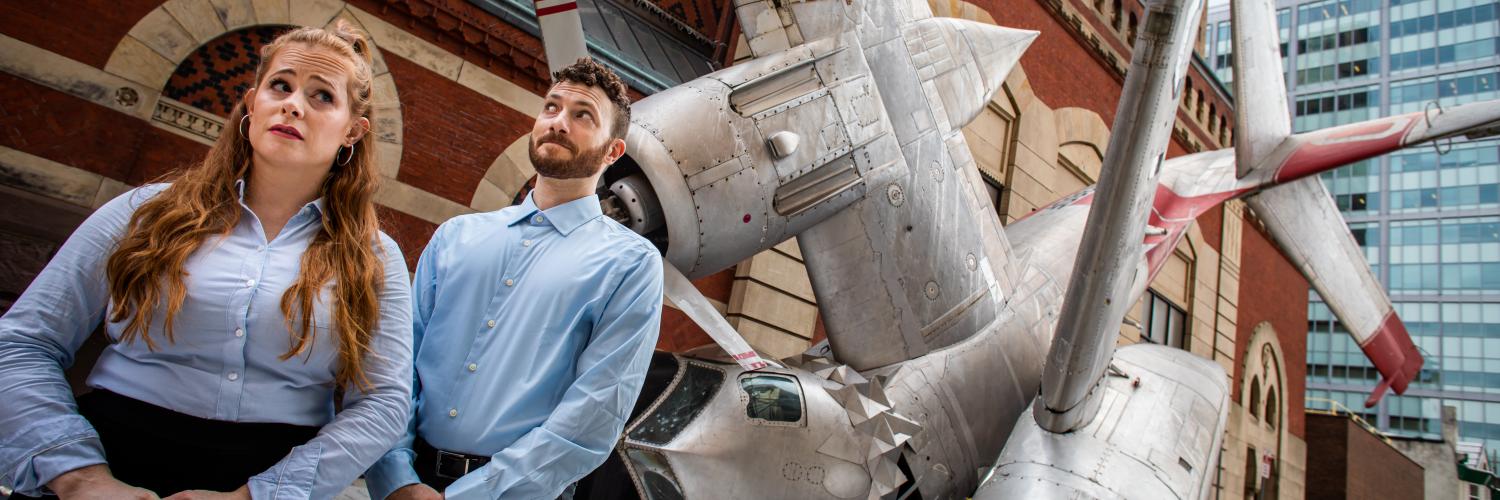
Pope John Paul II arrives on Aer Lingus during his trip to Ireland, 1979.
Flying in 1981 | Aer Lingus Flight 164 | Our Lady of Fátima | Glossary
Flying in 1981
In the early 1980s, the airline industry was in a transition period. Flying was in the process of changing from being an expensive luxury for the affluent upper classes to being affordable for much of the world. The main reasons for this change were technology. The invention and widespread use of the jet engines had replaced propeller-driven planes, making flying long distances much cheaper and easier.
Flying in Ireland, since Aer Lingus essentially held a monopoly until the 1980s, was still quite expensive. A walk-on fare for an Aer Lingus flight from Dublin to London (the route of Aer Lingus Flight 164) in the early 80s was about £240 in today’s value, and often cost as much as £1000. This was unaffordable to most in Ireland, and it took the creation of the private airline Ryanair to revolutionize air travel in Ireland by offering cheap flights all over Europe.
Airport security in the early 80s, despite occasional hijackings, was fairly relaxed. This was before 9/11 and the security revolution that followed, and airports were far more open. In many places, you could board and sit on a plane without buying a ticket, which means that family and friends could wait with travellers until essentially the moment they took off. Smoking was allowed on nearly all planes, and in fact cigarettes were a major part of the culture of flying at this time. It was not until 1990 that smoking was banned on most domestic US flights.
Being a flight attendant, often referred to as an “air hostess,” was still quite a glamorous and desirable profession for women at this time. Uniforms would be designed by leading fashion designers, often reflecting and even shaping the latest fashion trends. They were in many ways the public faces of their respective airlines, much more than they are today. And since many countries, including Aer Lingus in Ireland, essentially only had one national airline, the attendants were faces not only of their airline but of their country. They had and still have an active role in the actual operations of an aircraft, making up part of the cabin crew. Most notably, they still give presentations of the safety procedures of the aircraft during the taxi portion of the flight.
Aer Lingus
Aer Lingus is the official “flag carrier” airline of Ireland, which means it is directly affiliated with the government of the Republic of Ireland. Aer Lingus was founded by the Irish government in 1936. The name Aer Lingus, comes from the Irish word aerloingeas, meaning “air fleet.”
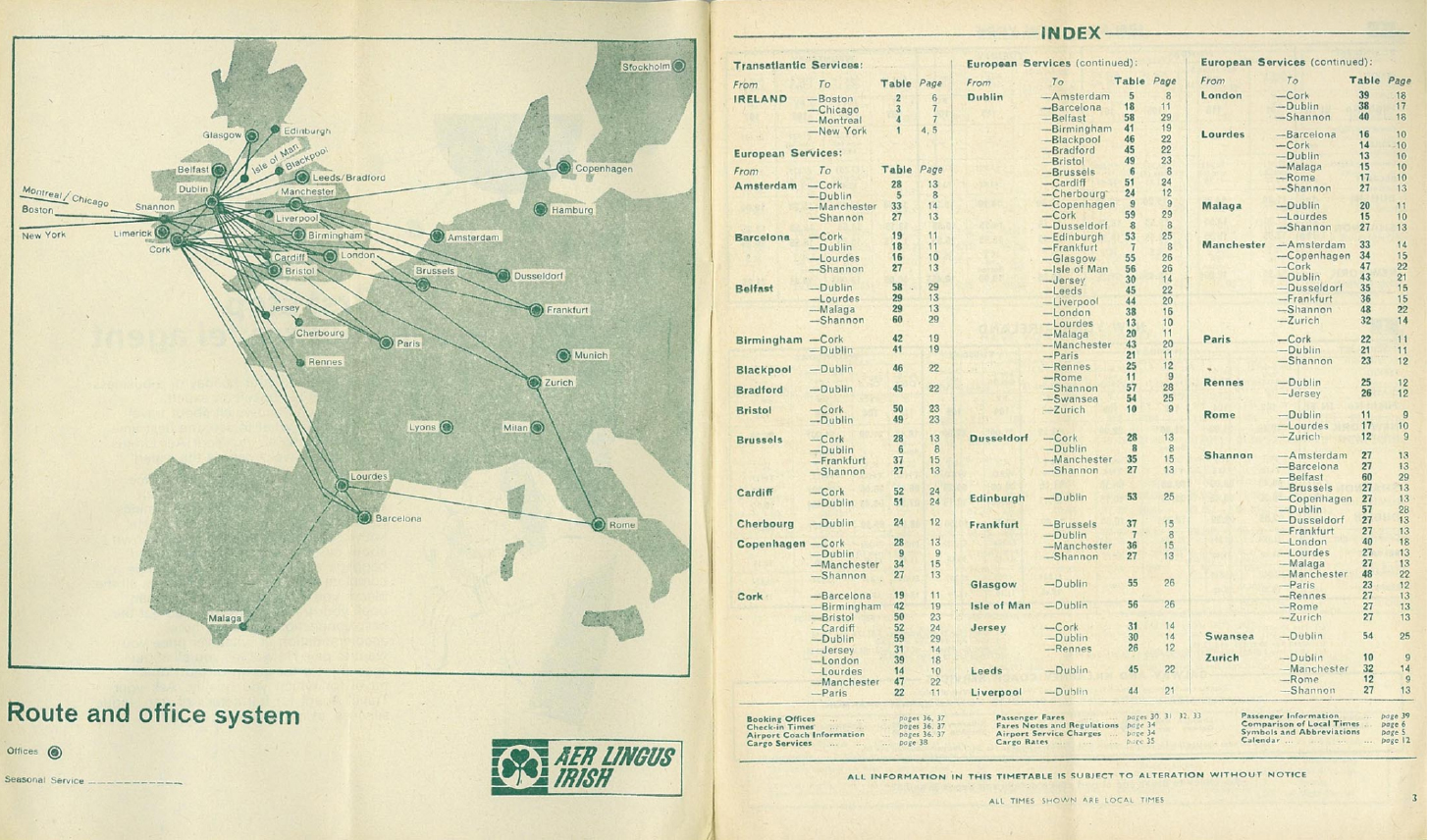
Aer Lingus flight routes in the 1970s
Aer Lingus mostly operated flights between England and Ireland for its first decade of existence. By 1966, they offered transatlantic flights to the United States and Canada, flying to New York, Boston, Montreal, and Chicago, as well as around Europe. Aer Lingus’s service to Rome got special attention in 1979, when Pope John Paul II flew Aer Lingus for his monumental trip to Ireland.
Aer Lingus essentially held a monopoly on air travel into and out of Ireland until the late 1970s and early 80s, when rival airlines Iona National Airways and Ryanair were founded. Ryanair especially hurt Aer Lingus by offering extremely cheap flights to other EU countries, and today is one of the largest and most popular airlines in all of Europe. Today, Aer Lingus is still a major airline in Ireland, second to Ryanair in passengers, and still enjoys a certain prestige and semi-official status from its government history.
A History of Plane Hijackings
When we think of plane hijackings today, likely one event comes to mind first: 9/11. The events of September 11, 2001 were the deadliest plane hijackings in world history, and marked the first time that hijacked planes were used as weapons to destroy targets. However, this specific image of airplane hijacking is more of an exception to the rule, and is an outlier in the history of hijackings.
The majority of plane hijackings go something like this: a person, armed (or not) with the potential to kill the pilots or everybody onboard, attempts to force the pilots to fly the planes to a destination desired by the hijacker. Sometimes, they may be planning to hold the passengers or crew as hostages, usually for money, political demands, or some other personal reason. Most hijackings are resolved peacefully, either by pilots accepting the hijacker’s demands or by negotiators or authorities forcing the hijacker to stand down.
Timeline
Early 1960s: plane hijackings start to become more prevalent, as there were only a handful of incidents occurring prior to 1960. The majority of hijackers in the US attempted to fly to Cuba, recently banned for travel after Fidel Castro came to power in 1959. This led to increased safety procedures, including placing US Marshals on flights and locking cockpit doors.
1968-1972: During these five years, there were 326 hijacking attempts, or a plane hijacking every 5.8 days. This period is sometimes referred to as the “Golden Age of Hijacking”. Hijackings were so common that they became a large part of American culture. The phrase “take me to Cuba”, referring to the demands of many hijackers, became a national catchphrase and joke. Time magazine ran a satirical article in 1968 called “What to Do When the Hijacker Comes.” Airport, a movie about a man who plots to blow up a 707, became one of the highest grossing movies of 1970. This period declined when the US government forced airports to implement security measures like metal detectors and baggage checks. This period is of particular interest because it is the only time in history when plane hijackings were, in large part, viewed in a kind of casual and even lighthearted way. While occasionally hijackings did result in deaths or danger, there was an unusual humorous view of the subject and even occasional empathy with the hijackers.
1980-2001: Hijackings became less frequent, but more deadly and dangerous. Plane hijacking started to move away from demands to visit Cuba or get money to political demands and international terrorism. Pan Am Flight 103, otherwise known as the Lockerbie bombing, was destroyed by Libyan terrorists above the Scottish coast. Air India Flight 182 was bombed over the coast of Ireland by Canadian Sikh extremists. These events and others caused plane hijackings to become largely carried out by terrorist and political organizations.
2001-present: After 9/11, the world finally got serious about airport security. Organizations like the TSA started to track hijacking threats more closely than ever before. As a result, there have not been many hijackings since 9/11, though there have been a few.
Aer Lingus Flight 164: What Really Happened
On May 2nd, 1981, Aer Lingus Flight 164 departed Dublin Airport on a short routine flight to London. The plane, a Boeing 737-200, was piloted by Eddie Foyle. There were 103 passengers and 10 crew members onboard. Most of the passengers were business travellers, with a few tourists and emigrants also aboard.
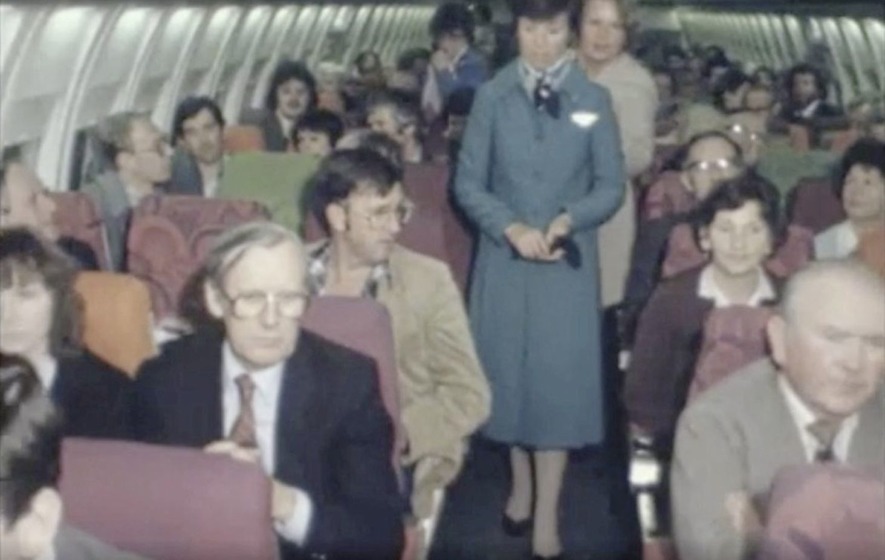
Passengers on Aer Lingus Flight 164. Photo: RTE Archive
The flight went smoothly for nearly its entire trip, until the plane prepared to descend into Heathrow Airport. The “fasten seatbelt” sign went on, and Laurence James Downey, with grey thinning hair, dressed in a blue lumberjack shirt and grey trousers, got up to use the lavatory. A crew member spotted Laurence, and kept an eye on the lavatory. Inside, Laurence rubbed petrol on his hands and doused himself in water. He returned to the cabin, where he spoke to air hostess Deidre Dunphy. This is her recollection of what happened next: "When I turned around this passenger was there and he was covered in petrol. He had two little vials and said they were cyanide gas." Contemporary news reports reported that he had doused himself in gasoline and carried a lighter.
Laurence Downey went into the cockpit and demanded that the plane fly to Tehran, Iran. News reports suggest that he had written his own constitution for the country and wanted to personally deliver it. The pilot told Downey that they did not have enough fuel to reach Iran, and that they would need to refuel in order to reach Tehran. Downey demanded that they refuel, and the plane was diverted from London to Le Touquet — Côte d'Opale Airport on the northern coast of France. In the meantime, the Iranian Foreign Ministry had formally announced over state radio that the plane would not be allowed to land in Tehran because the motives of the hijacker were unclear. While pilot Foyle was dealing with Downey, the co-pilot took control of the plane, and crew members calmed passengers down. Deidre Dunphy remembers that "We didn't tell them at any stage that we were being hijacked. Some of them obviously realised and one man said to me are we being hijacked and I just nodded to him. But we never actually used the word hijacked." According to passenger Kevin Kelly, the captain made the following announcement: “Ladies and gentlemen, we would like to land in London, but there is a gentleman here who would like to go on to Le Touquet.”
By now, government officials in both Ireland and France were aware of the situation. Irish Transportation Manager (and future Taoiseich, or prime minister) Albert Reynolds flew to France to deal with the situation. French anti-terrorist squads rushed to Le Touquet to await further instructions. Reports of the incident had begun to trickle out, and at this time many people in the press and government believed that the hijacker was Iranian given his demand. Many in Ireland also believed that the hijacking was connected to the then-ongoing hunger strike of Bobby Sands, an Irish Republican Army member who died two days after the hijacking, the biggest news story in the country at the time of the event.
Once Downey realized he would not be able to fly to Tehran, the situation took an unexpected turn. Downey revealed to the crew that he had been a former Trappist monk, and that his real goal was to force the Vatican to release the Third Secret of Fátima. He told the pilot that he would not surrender until the press, specifically the Irish press, agreed to publish a nine-page manifesto entitled “The Third Secret of Fátima.” According to one newspaper report, this was how the report began:
“A former Trappist monk from a monastery in Rome reveals after 20 years how a simple punch in the nose of his superior, which led to his excommunication and expulsion from the cloister, became the means whereby the greatest secret of all time was revealed.” The report also mentioned a vision in which Downey saw himself in concert with Padre Pio and Pope John XXIII - "since I am the sole remaining survivor the onus rests with me to make it work, for now is the acceptable time."
Five women and children were released from the plane at this time. According to reports, the hijacker himself personally requested this. The pilot told Downey that the Sunday Independent of Dublin had agreed to publish the manifesto, and the pilot himself threw it out the window onto the tarmac. A few moments later, French forces boarded the plane and entered the cockpit. Downey surrendered without a fight. It was later revealed that he was armed only with a bottle of water. In a truly hilarious and surreal moment, two passengers jumped up when they heard running down the aisle towards the cockpit. Thinking that the footsteps were an angry passenger, the two passengers jumped the man. One of the two passengers recalls that “it was a French gendarme who shrugged us off quite gently and led a squad into the cockpit to overpower the man.”
The passengers, already stranded for 8 hours, had to wait until Transportation Minister Reynolds personally boarded the plane and greeted them to be freed from the aircraft. They were all treated to a complementary French meal along with their French policemen who had freed them. After this, an ordeal that may have lasted as much as 12 hours, they reboarded the Aer Lingus aircraft and flew to London.
Laurence Downey
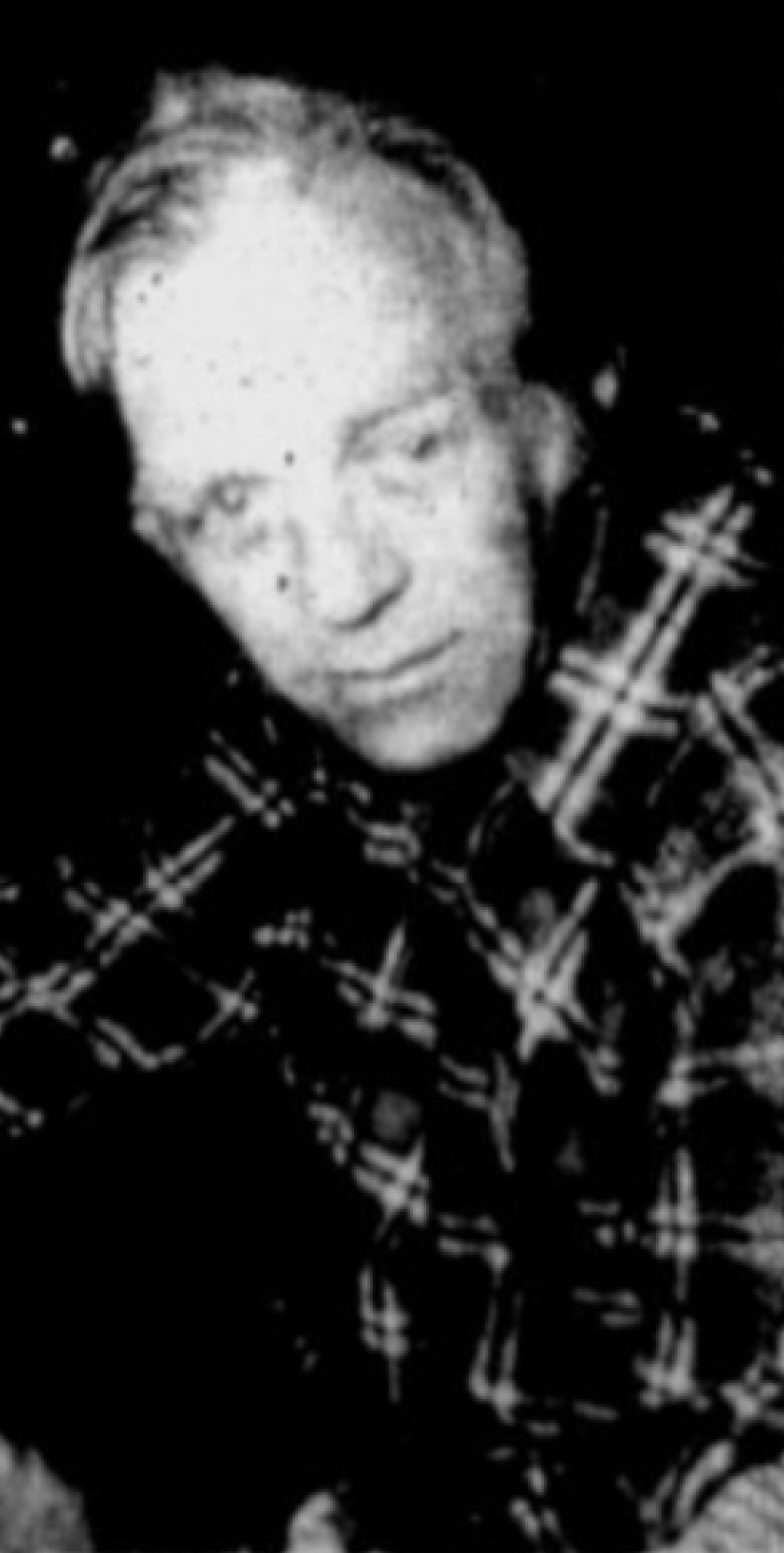
Laurence James Downey
Laurence James Downey was born in Perth, Australia in 1926. He was Anglo-Irish, and not much is known about his childhood, except that one of his sisters became a Catholic nun. In 1950, Laurence became a Trappist monk at the Tre Fotnane monastery in Rome. His time at the monastery lasted five years, when, for reasons still unknown, he punched a superior monk in the nose. He was then excommunicated from the monastery. After this, he travelled to Portugal and became a tour guide at the Shrine of Our Lady of the Rosary in Fátima. This was the site where in 1917, the Virgin Mary appeared to three children and revealed the Three Secrets to them.
Laurence returned to Australia, where he had raised five children with his wife. He took a number of unusual jobs during this time, such as a carpenter, and even apparently professional boxer. He became wanted in Perth for $70,000 worth of land fraud. He then moved to Ireland in 1978, where he lived at the time of the hijacking. He set up a language school in Shannon, and was very involved in local affairs there. He apparently tried to get a 20,000 seat all purpose stadium built in Shannon, and when they rejected this, he felt personally slighted.
Downey was not a legal immigrant in Ireland, and faced deportation back to Australia if he was caught. He went into hiding, and became more and more desperate. Downey, with his British and Irish heritage, had very strong feelings about Irish politics, especially the often violent movement in the Republic of Ireland to end British rule in Northern Ireland. Here is what he had to say on the matter:
“Expulsion was the last straw. Because I am Anglo-Irish, ‘Brits Out’ has become a personal matter and the Irish part of me has turned to anger. The history of all hitherto existing Irish Society is the history of conflict and division among themselves. Right back to the time of Wolfe Tone angry and violent men have adopted self-destruction, individual and national suicide as the foundation stone on which to build Irish Freedom."
In 1983, Downey was sentenced in France to five years in prison for air piracy. In letters to then Taoiseach Garret FitzGerald from his prison cell, Downey revealed a lot about his intentions. He wrote that he had the IRA hunger strikes, the biggest story in Ireland in 1981, on his mind when he hijacked the flight. He viewed the intentions of the hunger strikers as being “suicide” and foolish, and said that “Consistent with the national and individual spirit of suicide, I decided to fight fire with fire by faking a suicide attempt.” He obviously cared very much about Ireland, and felt persecuted and singled out during his entire time there. He said the following: "I went to Ireland thinking she was an oppressed underdog. I tried to help in the hope that I might be accepted in the land of my ancestors, but they hated me without cause and told me not to interfere." He was freed after 18 months and returned to Australia.
Our Lady of Fátima
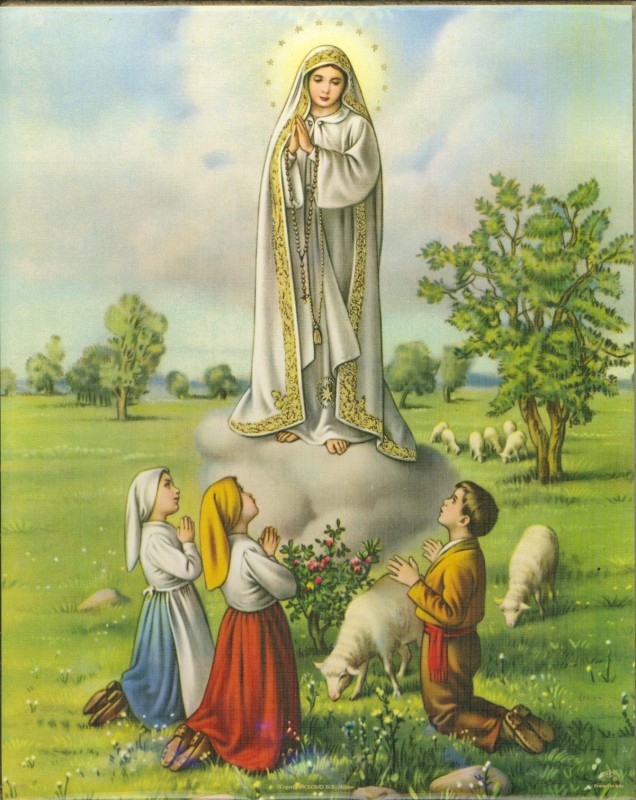
Holy card depicting the apparition of the Virgin Mary to the children of Fátima.
In 1917, Europe was engulfed in the First World War, a calamity the likes of which the world had never seen before. In the midst of this, in Fátima, Portugal, three children, Lúcia de Jesus Rosa dos Santos, Francisco de Jesus Marto, and Jacinda de Jesus Marto, began reporting miraculous visions. They reported six visions of the Blessed Virgin Mary in Cova de Iria, describing her as “a Lady more brilliant than the Sun”. The children stated that Mary would appear on October 13th and perform a miracle “so that all may believe”. This generated enormous publicity, and thousands began traveling to Portugal to see these visions for themselves. However, this also generated controversy in Portugal, with some believing these visions were politically motivated, and the children were briefly arrested. On October 13th, in a crowd of tens of thousands, an event known as the Miracle of the Sun occurred, where people reported spectacular visions of the Sun dancing around and emitting vivid colors. The Church confirmed these miracles and the apparitions eventually became venerated as Our Lady of Fátima.
In 1941, Lúcia de Jesus Rosa published a memoir. In it, she claimed that three secrets had been entrusted to the children by Mary during an appearance on July 13th, 1917. She described the first secret, known as the Vision of Hell, in the book:
“Our Lady showed us a great sea of fire which seemed to be under the earth. Plunged in this fire were demons and souls in human form, like transparent burning embers, all blackened or burnished bronze, floating about in the conflagration, now raised into the air by the flames that issued from within themselves together with great clouds of smoke, now falling back on every side like sparks in a huge fire, without weight or equilibrium, and amid shrieks and groans of pain and despair, which horrified us and made us tremble with fear. The demons could be distinguished by their terrifying and repulsive likeness to frightful and unknown animals, all black and transparent. This vision lasted but an instant. How can we ever be grateful enough to our kind heavenly Mother, who had already prepared us by promising, in the first Apparition, to take us to heaven. Otherwise, I think we would have died of fear and terror.”
Lúcia described a second secret, which had multiple parts to it. First, the secret said that World War I would end, which happened the following year. However, the secret warned that another war was possible during the reign of Pope Pius XI (from 1922-1939) if people continue offending God and Russia, which had recently declared state atheism under the newly founded Soviet Union, did not convert to Christianity. Some people believe that this vision predicted World War II. Here is what she said:
“God wishes to establish in the world devotion to my Immaculate Heart. If what I say to you is done, many souls will be saved and there will be peace. The war is going to end; if people do not cease offending God, a worse one will break out during the pontificate of Pius XI. When you see a night illumined by an unknown light, know that this is the great sign given you by God that He is about to punish the world for its crimes, by means of war, famine, and persecutions of the Church and of the Holy Father. To prevent this, I shall come to ask for the consecration of Russia to my Immaculate Heart, and the communion of reparation on the first Saturdays. If my requests are heeded, Russia will be converted, and there will be peace. If not, she will spread her errors throughout the world, causing wars and persecutions of the Church. The good will be martyred, the Holy Father will have much to suffer, various nations will be annihilated. In the end, my Immaculate Heart will triumph. The Holy Father will consecrate Russia to me, and she will be converted, and a period of peace will be granted to the world.”
The Third Secret
Lúcia did not disclose the third secret in her memoir. She fell seriously ill two years later, and a bishop suggested that she write down the vision so it may be preserved in the event she died. She did, and a sealed envelope was eventually sent to the Vatican in Rome.
Lúcia did not disclose the third secret in her memoir. She fell seriously ill two years later, and a bishop suggested that she write down the vision so it may be preserved in the event she died. She did, and a sealed envelope was eventually sent to the Vatican in Rome.
In 1960, the Vatican announced that the third secret would likely remain sealed forever. This announcement brought considerable publicity to the secrets, which before then had not generated much interest. Speculation as to what the secret contained became widespread, and varied widely. A popular belief was that the secret predicted a Third World War, which, given that the Cold War was going on at the time, many believed to mean nuclear war.
Eventually, on June 26th, 2000, the Vatican released the text of the third secret. The Vatican announced that the secret had predicted the continued persecution of Christians in the 20th century, which eventually culminated in the attempted assasination of Pope John Paul II on May 13, 1981. John Paul, even before the revelation, had always credited Our Lady of Fátima with surviving, and a bullet extracted from his body was placed in the gold crown worn by the official statue of the Virgin in 1982. Ironically, the Pope’s attempted assassination, supposedly predicted in the third secret according to the Vatican, occurred less than two weeks after Laurence Downey hijacked Aer Lingus Flight 164, demanding the Vatican release the third secret. Here is the full text:
“J.M.J. [meaning Jesus.Mary.Joseph]
The third part of the secret revealed at the Cova da Iria-Fátima, on 13 July 1917. I write in obedience to you, my God, who command me to do so through his Excellency the Bishop of Leiria and through your Most Holy Mother and mine. After the two parts which I have already explained, at the left of Our Lady and a little above, we saw an Angel with a flaming sword in his left hand; flashing, it gave out flames that looked as though they would set the world on fire; but they died out in contact with the splendour that Our Lady radiated towards him from her right hand: pointing to the earth with his right hand, the Angel cried out in a loud voice: 'Penance, Penance, Penance!'. And we saw in an immense light that is God: 'something similar to how people appear in a mirror when they pass in front of it' a Bishop dressed in White 'we had the impression that it was the Holy Father'. Other Bishops, Priests, men and women Religious going up a steep mountain, at the top of which there was a big Cross of rough-hewn trunks as of a cork-tree with the bark; before reaching there the Holy Father passed through a big city half in ruins and half trembling with halting step, afflicted with pain and sorrow, he prayed for the souls of the corpses he met on his way; having reached the top of the mountain, on his knees at the foot of the big Cross he was killed by a group of soldiers who fired bullets and arrows at him, and in the same way there died one after another the other Bishops, Priests, men and women Religious, and various lay people of different ranks and positions. Beneath the two arms of the Cross there were two Angels each with a crystal aspersorium in his hand, in which they gathered up the blood of the Martyrs and with it sprinkled the souls that were making their way to God.
Tuy-3-1-1944.”
Glossary
White lemonade: In Ireland, lemonade comes in three different varieties: red, white, and brown. White lemonade is the equivalent of what the rest of the world calls lemonade.
Lilt: a tropical soft drink that is sold only in Ireland and the UK.
DUP: Democratic Unionist Party, a right-wing unionist political party in Northern Ireland.
East Timor is an island nation in Southeast Asia invaded and occupied by Indonesia in 1975, which became known for massacres, sexual slavery, and other atrocities.
Shergar: a very successful Irish thoroughbred racehorse. Shergar is best remembered for being kidnapped and killed in 1983 by nine members of the IRA.

Ulster Fry
Ulster fry: a variety of the Irish breakfast that is found in the Ulster region of Ireland. This includes traditional ingredients like bacon, sausage, and eggs. One specific Northern Ireland variation is the “filled soda”, the equivalent of a breakfast roll with a soda farl used for bread instead of a roll.
Rose of Tralee: an annual pageant held in Tralee, County Kerry in Ireland named after a traditional song about a man in love with an Irish woman.
Carlos the Jackal: one of the most notorious international political criminals of the 1970s.
Baader-meinhof: otherwise known as the Red Army Faction (RAF), a far-left militant group founded in West Germany in 1970.
“Son of Sam”: David Berkowitz, a notorious serial killer who killed eight people in New York City between 1975 and 1977.
Margaret Thatcher: Prime Minister of the UK from 1979 to 1990. Known for her brash, unique brand of conservative leadership known as Thatcherism.
Feis: a traditional Gaelic arts and culture festival, often focusing on traditional Irish dance.
Switzer’s: a popular department store in Dublin, known for selling high-end fashion and perfume.
Taoiseach: the prime minister of Ireland. Transportation Minister Albert Reynolds in the play would go on to become Taoiseach in 1992.
Pope John Paul II: head of the Catholic Church from 1978 to his death in 2005. A massively popular figure in his day, his visit to Ireland in 1979 was a major national cultural event.
Research thanks to our wonderful dramturg, William Forrest.
